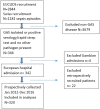Group A streptococcal disease in paediatric inpatients: a European perspective
- PMID: 36449079
- PMCID: PMC9709363
- DOI: 10.1007/s00431-022-04718-y
Group A streptococcal disease in paediatric inpatients: a European perspective
Erratum in
-
Correction to: Group A streptococcal disease in paediatric inpatients: a European perspective.Eur J Pediatr. 2023 Feb;182(2):707. doi: 10.1007/s00431-022-04787-z. Eur J Pediatr. 2023. PMID: 36689004 Free PMC article. No abstract available.
Abstract
Group A streptococcal (GAS) disease shows increasing incidence worldwide. We characterised children admitted with GAS infection to European hospitals and studied risk factors for severity and disability. This is a prospective, multicentre, cohort study (embedded in EUCLIDS and the Swiss Pediatric Sepsis Study) including 320 children, aged 1 month to 18 years, admitted with GAS infection to 41 hospitals in 6 European countries from 2012 to 2016. Demographic, clinical, microbiological and outcome data were collected. A total of 195 (61%) patients had sepsis. Two hundred thirty-six (74%) patients had GAS detected from a normally sterile site. The most common infection sites were the lower respiratory tract (LRTI) (22%), skin and soft tissue (SSTI) (23%) and bone and joint (19%). Compared to patients not admitted to PICU, patients admitted to PICU more commonly had LRTI (39 vs 8%), infection without a focus (22 vs 8%) and intracranial infection (9 vs 3%); less commonly had SSTI and bone and joint infections (p < 0.001); and were younger (median 40 (IQR 21-83) vs 56 (IQR 36-85) months, p = 0.01). Six PICU patients (2%) died. Sequelae at discharge from hospital were largely limited to patients admitted to PICU (29 vs 3%, p < 0.001; 12% overall) and included neurodisability, amputation, skin grafts, hearing loss and need for surgery. More patients were recruited in winter and spring (p < 0.001).
Conclusion: In an era of observed marked reduction in vaccine-preventable infections, GAS infection requiring hospital admission is still associated with significant severe disease in younger children, and short- and long-term morbidity. Further advances are required in the prevention and early recognition of GAS disease.
What is known: • Despite temporal and geographical variability, there is an increase of incidence of infection with group A streptococci. However, data on the epidemiology of group A streptococcal infections in European children is limited.
What is new: • In a large, prospective cohort of children with community-acquired bacterial infection requiring hospitalisation in Europe, GAS was the most frequent pathogen, with 12% disability at discharge, and 2% mortality in patients with GAS infection. • In children with GAS sepsis, IVIG was used in only 4.6% of patients and clindamycin in 29% of patients.
Keywords: Child; Hospital; Outcome; Streptococcus pyogenes.
© 2022. The Author(s), under exclusive licence to Springer-Verlag GmbH Germany, part of Springer Nature.
Conflict of interest statement
The authors declare no competing interests.
Figures



References
-
- Sanderson-Smith M, De Oliveira DM, Guglielmini J, McMillan DJ, Vu T, Holien JK, et al. A systematic and functional classification of Streptococcus pyogenes that serves as a new tool for molecular typing and vaccine development. J Infect Dis. 2014;210(8):1325–1338. doi: 10.1093/infdis/jiu260. - DOI - PMC - PubMed
MeSH terms
Grants and funding
LinkOut - more resources
Full Text Sources
Medical

